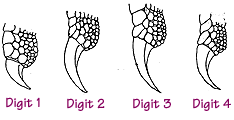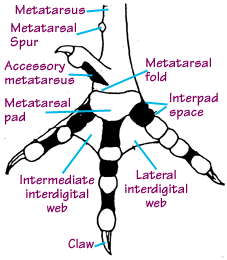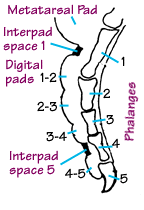|
The foot of the bird contains only part of the ankle bones. In mammals,
all of the ankle bones are included as part of the foot.
Poultry raisers use the term "hock" synonymous with the ankle region
and "hockjoint" with ankle joint. The bird does not have a well developed
calcaneum, which forms the heel of man.
No bird has more than four toes except chickens of the Dorking, Faverolle,
Houden, Sultan, and Non-bearded Silkie Bantams, all of which have five
toes. In these breeds the extra toe arises above the base of the hallux
and projects upward, never touching the ground. In the Silkie, the extra
toes often lie nearly in the same plane as the hallux. Some birds have
only three toes, while the ostrich has two toes.
Coues in 1903 classified avian feet according to the position of the
first digit as elevated, insistent (the tip touches the ground), or incumbent,
full length of the first toe touches the surface on which the bird rests.
All domestic fowl are included in the Galliforms.
In poultry literature, reference is made to booted and booting. This
refers to feathering of the metatarsus rather then to a fusion of scales.
"Ptilopody" would be a better term to designate leg feathering.
 The claws in chickens are relatively short and not greatly curved and
serve the function of scratching.
The claws in chickens are relatively short and not greatly curved and
serve the function of scratching.
The chicken metatarsus has four surfaces, but they are not of equal
size and some have an irregular shape. The two or three scutes on the
forward surface of the metatarsus aid in identifying the anterior surface.
The marginal boundaries can be seen fully only in medial and lateral views,
but the encircling proximal and distal boundaries can be seen in several
views. The proximal boundary is common with the ankle region; the distal
boundary is the caudal end of the tarsometatarsus at the junction with
the basal end of toes II, III, and IV.
The posterior boundary follows the margins of the medium size scutella
on the caudal surface of the metatarsus. The medial margin of the posterior
surface bypasses the base of the metatarsal spur so that the spur is included
in the medial surface. The inferior boundary of the posterior surface
was placed at the basal end of the accessory metatarsus.
 The metatarsal spur, like the beak and claws, has two parts: the underlying
osseous structure and the covering of heavily keratinized epidermis. The
spurs in the chicken project from the axis of the metatarsus at an angle
of about 90 degrees and are pointed posteromedially at about a 45 degree
angle. They are placed between the middle and distal thirds of the metatarsus.
The metatarsal spur, like the beak and claws, has two parts: the underlying
osseous structure and the covering of heavily keratinized epidermis. The
spurs in the chicken project from the axis of the metatarsus at an angle
of about 90 degrees and are pointed posteromedially at about a 45 degree
angle. They are placed between the middle and distal thirds of the metatarsus.
The proximal and distal joints are the reference landmarks for the foot;
the latter is more readily palpable. These joints are circular because
the accessory metatarsus is rodlike. (Refer to the figure on the next
page for details.) Below the accessory metatarsal is a thickening called
the metatarsal fold; it lies between the metatarsal pad and the base of
digit I. The metatarsal pad is at the end of the tarsometatarsal bone.
Its boundary is well indicated by the crease on one side between fold
and pad and on the other side between pad and bases of toes.
The joint between tarsometatarsus and the bases of thirds and fourth
digits established the distal end of the medial surface of the metatarsus.
The lateral surface, like the medial surface, is broad adjacent to the
ankle, and it narrows distally to a point between accessory metatarsus
and fourth digit. It contains reticulate scales.
 The phalangeal formula for the chicken is 2, 3, 4, 5. The first toe is
the shortest, the third is the longest; the fourth toe has five phalanges
and is only slightly longer then the second with three phalanges. In the
chicken all flanges are relatively long except the terminals and those
of the fourth toe. Although round in cross section, the toes seem to be
divided into dorsal and ventral surfaces, based chiefly on scale structure
and placement of the interdigital webs.
The phalangeal formula for the chicken is 2, 3, 4, 5. The first toe is
the shortest, the third is the longest; the fourth toe has five phalanges
and is only slightly longer then the second with three phalanges. In the
chicken all flanges are relatively long except the terminals and those
of the fourth toe. Although round in cross section, the toes seem to be
divided into dorsal and ventral surfaces, based chiefly on scale structure
and placement of the interdigital webs.
The chicken has an intermediate interdigital web joining toes II and
III and a lateral interdigital web joining toes III and IV. The webs in
the chicken extend no farther than the distal ends of the basal phalanges.
The free edges of the webs are curved with the concavity outward. The
webs are located at the junction of the dorsal and ventral surfaces of
the toes, and their surfaces are covered with small reticulate scales.
|